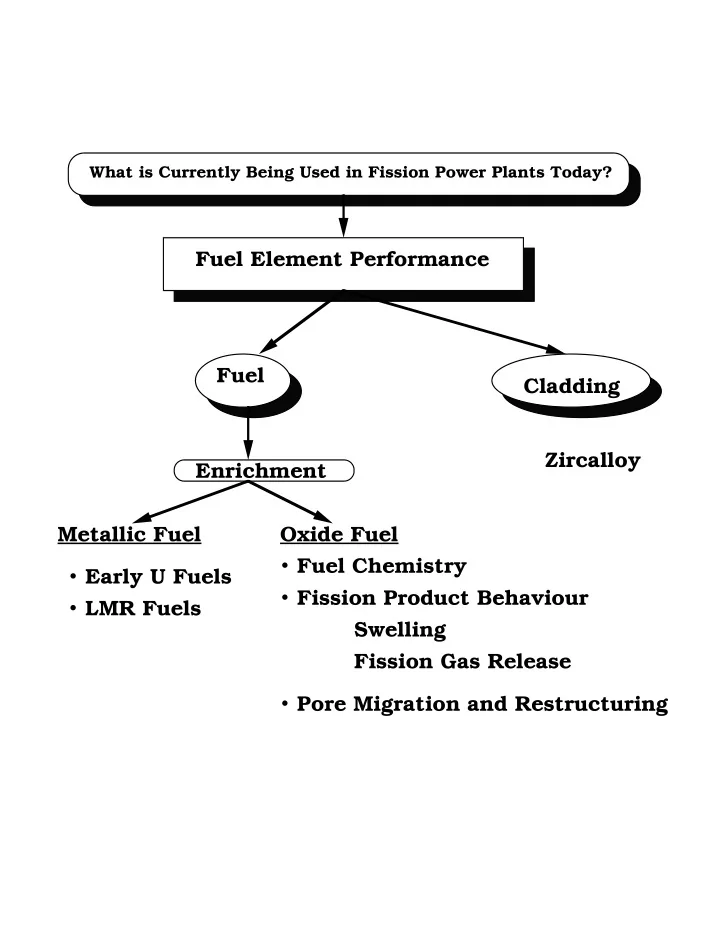

What is Currently Being Used in Fission Power Plants Today? Fuel Element Performance Fuel Cladding Zircalloy Enrichment Metallic Fuel Oxide Fuel ¥ Fuel Chemistry ¥ Early U Fuels ¥ Fission Product Behaviour ¥ LMR Fuels Swelling Fission Gas Release ¥ Pore Migration and Restructuring
Metallic Fuels ¥ During first 10 years of fission reactor research almost all fuels were metallic. ¥ Now ( see last lecture) practically all power reactor fuels are oxides. Need fissionable isotope U235, ¥ t 1 2 =710 million years ___________________________________ Uranium Phases α =orthorhombic-----------a ≠ b ≠ c β = tetragonal -----------a=b ≠ c γ = body centered cubic--a=b=c (figure) Anisotropy of Alpha Uranium Phase Thermal Expansion Lattice Direction Coefficient • ° C -1 x 10 -6 (25-125) 100 2.852 21.17 010 5.685 -1.15 001 4.945 23.2 Volume 45.8
Nuclear Reactor Metallurgy, Walter D. Wilkinson and William F. Murphy, D. Van Nostrand Co., Inc., 1958.
Nuclear Reactor Metallurgy, Walter D. Wilkinson and William F. Murphy, D. Van Nostrand Co., Inc., 1958.
The crystal structure of gamma uranium. Nuclear Reactor Metallurgy, Walter D. Wilkinson and William F. Murphy, D. Van Nostrand Co., Inc., 1958.
Dimensional Stability 1.) Irradiation Growth Change of shape without appreciable volume change 2.) Irradiation Creep Change of shape under an external stress 3.) Swelling No change of shape but a change in volume Plus two other phenomena NOT related to irradiation ! A.) Thermal Racheting Thermal cycling of polycrystal textured specimen in α phase B.) Surface Roughing Cycling through the α−β phase transition
Necessary Definitions Problem: What unit to use in describing radiation damage in fissile material? --------------------------------------------------- Properties are more related to fission events than to neutron fluence ---------------------------------------------- No single definition satisfactory! A.) Reactor Designer - More concerned with power density than fission density B.) Reactor Physicist- More concerned with percentage of fissile atoms lost by all processes than with % fissioned C.) Material Scientists- CanÕt agree! i.e., a 70% burnup of U atoms in UO2 -Steel cermet means more than 3 x 1021 fissions/cm3
Deposit in fuel MWd Total t Energy ? ? Release ton tonne Energy per 235 U Fission 169 MeV - FP 5 MeV - n 5 MeV - γ total Just 12 MeV - FP Decay fuel ? U ? 8 MeV − β,γ Decay ----------- 199 MeV Instantaneous + 10-12 neutrinos Design Dependent
Another Unit Which is Misinterpreted - Fission cm 3 • Necessary for heat transfer calculations -3 • What is included in cm ? Normally it is not the cladding or the coating on the fuel pellets Fission =( frac. of U atoms fissioned) • cm 3 ( density of U in fuel) N f N A • nvt • f m ' N U where; N f = fraction of U atoms that can fission N U = fuel density m’ = M. Wt. of fuel/# of U atoms in molecule NA = Avogadros Number
Relate Burn -up and Integral Flux Let N = atoms of fissile isotopes c, f = capture and fission xsections, respectively dN Nnv a dt where a = c + f --------------------------------------------------- Integrating and finding the % of fissile atoms lost, one finds; N o N e nvt a 100 100 1 N o The % of atoms fissioned is then; f nvt a e 100 1 a when nvt a << 1, exp (-x) 1-x , % atoms fissioned = 100 nvt f -------------------------------------------------- since f 550 barns for 35 U in thermal flux; % B.U. of 35 U atoms = 55000 b • (nvt) If only a fraction of U atoms are fissionable; N f 100 • nvt f N U
Example • Assume 1 fission = 200 MeV 1 . 6 • 10 − 19 watt − s eV 1 day 200 • 106 • • 86 , 400 s fission eV 3.7 • 10 16 watt d fission ----------------------- watt d 1 fissions 3.7 • 10 16 • • cm 3 g fuel fuel • m ' 1 fissions MWd 3.7 • 10 16 • or, • cm 3 tonne U A fuel where A = atomic wt. of U -------------------------------------------- What if not all of the energy released is captured by the fuel? • can only count on 169 MeV K.E. of FP’s Plus 12 MeV Decay of FP's 1 fissions MWd 1.85 • 10 18 • • • E f cm 3 tonne fuel fuel where Ef is the fission energy (MeV) deposited in the fuel
Another way to express this is: E f • m ' MWd in fuel fissions 1.85 • 10 18 • • cm 3 tonne U A fuel -------------------------------------------------- What Have We Forgotten? 1.) Conversion of fertile to fissile ( important at low enrichments and at high burn up) 2.) Fast fission Few % in thermal reactors 3.) Absorption of gamma rays From the parent fuel rod or from surrounding fuel rods
MWd within fuel A m ' • tonne fuel MWd ⋅ within ⋅ fuel ' E f − 18 m = 1 . 85 • 10 • tonne ⋅ U A fissions N t 6.02 • 10 21 • • cm 3 m ' N U N U % of all atoms fissioned • N t N f f % of all U atoms fissioned 100 • N U neutron fluence nvt
Recommend
More recommend